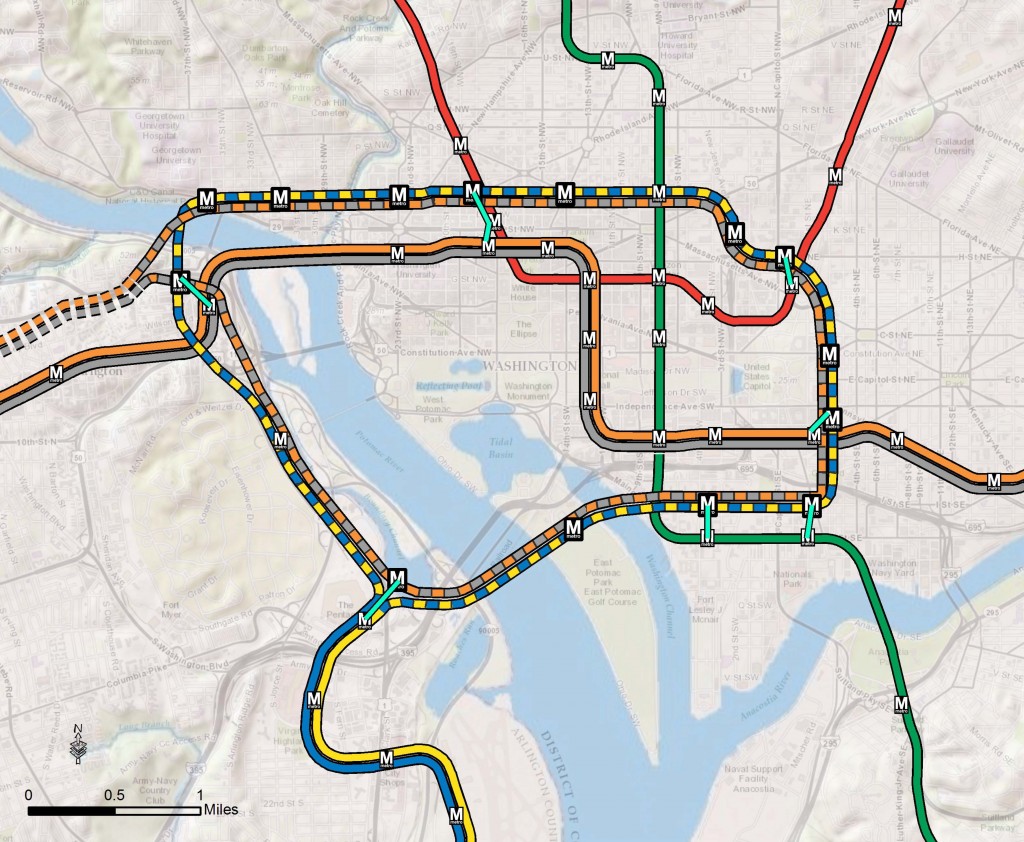
A map of today’s WMATA Metro service offerings. (Via Peter Dovak on Twitter)
Whenever we begin to think the MTA has pushed New York City toward an intractable transit situation, Washington DC’s WMATA makes such a load splash to remind us that it could be much, much worse. Yesterday, at around 4 p.m., news broke that, following a fire on Monday, the DC Metro had to shut down for emergency safety inspections. Due to safety concerns with the electricity deliver system that runs the subway in the nation’s capital, the DC Metro will not run at all today as crews inspect the entirety of the system’s power cables. If all goes according to plan, the Metro will reopen tomorrow at 5 a.m., but if anything is amiss, the shutdown could run longer.
The Washington Post, unsurprisingly, has had the most comprehensive coverage of the safety issues facing Metro and offered up a summary of the problem:
This is about the havoc electricity can cause when it gets loose, when it isn’t contained within power cables by tight, reliable insulation — when the juice finds a path out…Like all subway power lines, the jumper cables are heavily insulated. But if the insulation is compromised — if it wears out or is damaged — there is an excellent chance that trouble will soon follow.
Here is why: Moisture is commonplace in subway tunnels. So are “particulate contaminants,” including brake dust, rust flakes and metallic shavings from train wheels. There is also a lot of grime in the tunnels. And there is plenty of other gunk, such as oil. In electrical-speak, these are “conductive substances,” meaning they have a low resistance to electricity. They offer a path for electrical current to jump dangerously all over a tunnel if the electricity escapes from its insulated containment. All it takes is for a path to be completed — for a trail of moisture, particulates or other conductive material to come in contact with the exposed electrical current. The phenomenon is called “arcing.”
…Jumper cables and other power lines are attached to one another, and attached to third rails, by large, elbow-shaped connector assemblies called “boots.” In its investigation of the L’Enfant incident, the NTSB also warned that throughout the subway, “a number” of boots lacked the proper type of “sealing sleeves,” which are designed to keep contaminants away from the electrical current. Metro acknowledged that about 80 percent of its 6,400 power-cable connector assemblies lacked adequate sealing sleeves. Wiedefeld said Tuesday that about half of the faulty boots have been upgraded, but months of work on that project still remains.
It’s a rather technical discussion, but you get the point: The WMATA’s power delivery system is in danger of failing, and the consequences can be disastrous for riders. So the agency is going to inspect all 600 jumper cables today and made a decision, on around eight hours’ notice, to shutter for the entirety of a busy mid-week day.
As you can imagine, reaction has not been particularly kind. The WMATA has a long history of safety problems from collisions and derailments to seemingly spontaneous fires, and politicians in the region — who should bear some of the blame for this situation — aren’t happy. A Virginia representative called it “a gut punch to the hundreds of thousands of commuters who depend on the system,” and John Delaney of Maryland did not mince his words. “It is deeply disturbing that the system is in such a precarious state that it must be entirely and abruptly shut down during the middle of a workweek,” he said. “This is a stark demonstration of a total agency failure; now is the time for every stakeholder in WMATA to demand better performance and improved safety.”
Traffic isn’t moving as a combination of buses, bikes, taxis, private vehicles and a trolling 2.4 mile mixed-traffic streetcar are all trying to pick up the transportation slack, but that is nearly besides the point. The point, as regional growth advocacy groups have noted is a history of lack of support for ongoing maintenance combined with a culture that hasn’t emphasized system safety. Perhaps it’s because the WMATA is run, at various points, by two states with differing political outlooks, a barely-empowered District of Columbia and the federal government, all fighting with and against each other. Perhaps it stems from a lack of transparency and sustainable funding, as NARP alleged in a statement.
Around an hour or so before the shutdown was leaked and later confirmed, David Alpert, founder of Greater Greater Washington, published his comprehensive overview of the transportation problems plaguing Washington DC. Without a balanced growth plan, more support for the WMATA and steady funding, the nation’s capital will see its subway system slide further toward unreliability. It’s a fear we’ve seen realized in New York and one that always seems on the precipice of returning. Wednesday’s outage is a reminder of how our cities rely on transit systems that do not enjoy the political support and fiscal backing these systems need to stay healthy, and I’m not sure I see a clear way forward without a massive shift in public priorities and philosophies.




